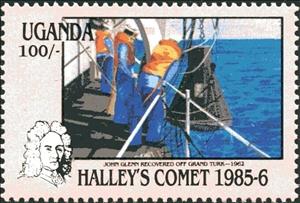Stamp: Recovery of Astronaut John Glenn, US space capsule (Uganda 1986)
Recovery of Astronaut John Glenn, US space capsule (Uganda 1986)
30 April (Uganda ) within release Halley´s Comet goes into circulation Stamp Recovery of Astronaut John Glenn, US space capsule face value 100 Ugandan shilling
| Stamp Recovery of Astronaut John Glenn, US space capsule in catalogues | |
|---|---|
| Michel: | Mi: UG 471 |
| Stamp Number: | Sn: UG 486 |
Stamp is square format.
Also in the issue Halley´s Comet:
- Stamp - Tycho Brahe and Arecibo radio telescope, Puerto Rico face value 50;
- Souvenir Sheet - Halley´s Comet over Hutchinson Falls face value 3,000;
- Stamp - Sighting, 1835, Davy Crockett at The Alamo face value 2,500;
- Stamp - Recovery of Astronaut John Glenn, US space capsule face value 100;
- Stamp - Adoration of the Magi by Giotto face value 140;
- Stamp - Halley´s Comet over Hutchinson Falls face value 3,000;
Stamp Recovery of Astronaut John Glenn, US space capsule it reflects the thematic directions:
An astronaut (from the Ancient Greek ἄστρον (astron), meaning 'star', and ναύτης (nautes), meaning 'sailor') is a person trained, equipped, and deployed by a human spaceflight program to serve as a commander or crew member aboard a spacecraft. Although generally reserved for professional space travelers, the term is sometimes applied to anyone who travels into space, including scientists, politicians, journalists, and tourists
A comet is an icy, small Solar System body that warms and begins to release gases when passing close to the Sun, a process called outgassing. This produces an extended, gravitationally unbound atmosphere or coma surrounding the nucleus, and sometimes a tail of gas and dust gas blown out from the coma. These phenomena are due to the effects of solar radiation and the outstreaming solar wind plasma acting upon the nucleus of the comet. Comet nuclei range from a few hundred meters to tens of kilometers across and are composed of loose collections of ice, dust, and small rocky particles. The coma may be up to 15 times Earth's diameter, while the tail may stretch beyond one astronomical unit. If sufficiently close and bright, a comet may be seen from Earth without the aid of a telescope and can subtend an arc of up to 30° (60 Moons) across the sky. Comets have been observed and recorded since ancient times by many cultures and religions.
A spacecraft is a vehicle that is designed to fly and operate in outer space. Spacecraft are used for a variety of purposes, including communications, Earth observation, meteorology, navigation, space colonization, planetary exploration, and transportation of humans and cargo. All spacecraft except single-stage-to-orbit vehicles cannot get into space on their own, and require a launch vehicle (carrier rocket).



